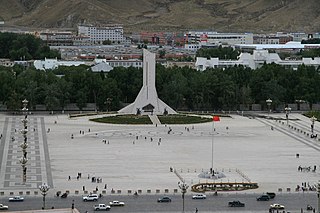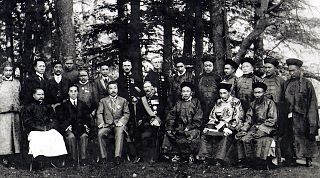
Tibet is a region in East Asia covering much of the Tibetan Plateau spanning about 2,500,000 km2 (970,000 sq mi). It is the traditional homeland of the Tibetan people as well as some other ethnic groups such as Monpa, Tamang, Qiang, Sherpa and Lhoba peoples and is now also considerable numbers of Han Chinese and Hui people settlers. Tibet is the highest region on Earth, with an average elevation of 4,380 m (14,000 ft). Located in the Himalayas, the highest elevation in Tibet is Mount Everest, Earth's highest mountain, rising 8,848.86 m (29,032 ft) above sea level.
The Five Principles of Peaceful Coexistence, also known as Panchsheel, were mentioned in the preamble of the Sino-Indian Agreement 1954. The principles were subsequently adopted in a number of resolutions and statements, including the preamble to the Constitution of China.

The McMahon Line is the boundary between Tibet and British India as agreed in the maps and notes exchanged by the respective plenipotentiaries on 24–25 March 1914 at Delhi, as part of the 1914 Simla Convention. The line delimited the respective spheres of influence of the two countries in the eastern Himalayan region along northeast India and northern Burma (Myanmar), which were earlier undefined. The Republic of China was not a party to the McMahon Line agreement, but the line was part of the overall boundary of Tibet defined in the Simla Convention, initialled by all three parties and later repudiated by the government of China. The Indian part of the Line currently serves as the de facto boundary between China and India, although its legal status is disputed by the People's Republic of China. The Burmese part of the Line was renegotiated by the People's Republic of China and Myanmar.

The Panchen Lama is a tulku of the Gelug school of Tibetan Buddhism. Panchen Lama is one of the most important figures in the Gelug tradition, with its spiritual authority second only to Dalai Lama. Along with the council of high lamas, he is in charge of seeking out the next Dalai Lama. Panchen is a portmanteau of Pandita and Chenpo, meaning "great scholar".

Princess Bhrikuti Devi of Licchavi, known to Tibetans as Bal-mo-bza' Khri-btsun, Bhelsa Tritsun, or simply, Khri bTsun, is traditionally considered to have been the first wife and queen of the earliest emperor of Tibet, Songtsen Gampo, and an incarnation of Tara. She was also known as "Besa", and was a princess of the Licchavi kingdom of Nepal and later the queen consort of Tibet.

The Tibetan independence movement is the political movement advocating for the separation and independence of Tibet from the People's Republic of China. It is principally led by the Tibetan diaspora in countries like India and the United States, and by celebrities and Tibetan Buddhists in the United States, India and Europe. The movement is no longer supported by the 14th Dalai Lama, who although having advocated it from 1961 to the late 1970s, proposed a sort of high-level autonomy in a speech in Strasbourg in 1988, and has since then restricted his position to either autonomy for the Tibetan people in the Tibet Autonomous Region within China, or extending the area of the autonomy to include parts of neighboring Chinese provinces inhabited by Tibetans. Additionally in 2017, the Dalai Lama asserted that Tibetans wanted to stay with China, and that they want more development from China.
The foreign relations of Tibet are documented from the 7th century onward, when Buddhism was introduced by missionaries from India and Nepal. The Tibetan Empire fought with the Tang dynasty for control over territory dozens of times, despite peace marriage twice. Tibet was conquered by the Mongol Empire and that changed its internal system of government, introducing the Dalai Lamas, as well as subjecting Tibet to political rule under the Yuan dynasty. Tibetan foreign relations during the Ming dynasty are opaque, with Tibet being either a tributary state or under full Chinese sovereignty. But by the 18th century, the Qing dynasty indisputably made Tibet a subject. In the early 20th century, after a successful invasion, Britain established a trading relationship with Tibet and was permitted limited diplomatic access to "Outer Tibet", basically Shigatse and Lhasa. Britain supported Tibetan autonomy under the 13th Dalai Lama but did not contest Chinese suzerainty; while "Inner Tibet", areas such as Amdo and Kham with mixed Chinese and Tibetan populations to the east and north, remained nominally under the control of the Republic of China although that control was seldom effective. Although the sovereignty of Tibet was unrecognized, Tibet was courted in unofficial visits from Nazi Germany, Imperial Japan, and the United States during and after World War II. The foreign relations of Tibet ended with the Seventeen Point Agreement that formalized Chinese sovereignty over most all of political Tibet in 1951.

Lobsang Trinley Lhündrub Chökyi Gyaltsen was the tenth Panchen Lama, officially the 10th Panchen Erdeni, of the Gelug school of Tibetan Buddhism. According to Tibetan Buddhism, Panchen Lamas are living emanations of the buddha Amitabha. He was often referred to simply as Choekyi Gyaltsen.

Lhasa Tibetan, or Standard Tibetan, is the Tibetan dialect spoken by educated people of Lhasa, the capital of the Tibetan Autonomous Region of China. It is an official language of the Tibet Autonomous Region.

Ngapoi Ngawang Jigme was a Tibetan senior official who assumed various military and political responsibilities both before and after 1951 in Tibet. He is often known simply as Ngapo in English sources.
Melvyn C. Goldstein is an American social anthropologist and Tibet scholar. His research focuses on Tibetan society, history and contemporary politics, population studies, polyandry, studies in cultural and development ecology, economic change and cross-cultural gerontology.

Elliot Sperling was one of the world's leading historians of Tibet and Tibetan-Chinese relations, and a MacArthur Fellow. He spent most of his scholarly career as an associate professor at Indiana University's Department of Central Eurasian Studies, with seven years as the department's chair.

Sinicization of Tibet includes the programs and laws of the Chinese government and the Chinese Communist Party (CCP) which force "cultural unity" in Tibetan areas of China, including the Tibet Autonomous Region and surrounding Tibetan-designated autonomous areas. The efforts are undertaken by China in order to remake Tibetan culture into mainstream Chinese culture.

The Simla Convention, also called Simla Accord; officially the Convention Between Great Britain, China, and Tibet, was an ambiguous treaty concerning the status of Tibet negotiated by representatives of the Republic of China, Tibet and Great Britain in Simla in 1913 and 1914.

The 14th Dalai Lama, known as Gyalwa Rinpoche to the Tibetan people, is the current Dalai Lama, the highest spiritual leader and former head of state of Tibet. Born on 6 July 1935, or in the Tibetan calendar, in the Wood-Pig Year, 5th month, 5th day. He is considered a living Bodhisattva; specifically, an emanation of Avalokiteśvara in Sanskrit and Chenrezig in Tibetan. He is also the leader and an ordained monk of the Gelug school, the newest school of Tibetan Buddhism, formally headed by the Ganden Tripa. The central government of Tibet, the Ganden Phodrang, invested the Dalai Lama with temporal duties until his exile in 1959. On 29 April 1959, the Dalai Lama established the independent Tibetan government in exile in the north Indian hill station of Mussoorie, which then moved in May 1960 to Dharamshala, where he resides. He retired as political head in 2011 to make way for a democratic government, the Central Tibetan Administration.

Tibet was a de facto independent state between the collapse of the Manchu-led Qing dynasty in 1912 and the annexation of Tibet by the People's Republic of China in 1951.

Tibet Justice Center, is an American legal association founded in 1989 that advocates human rights and self-determination for the Tibetan people.
Dorje Tseten, also Duojie Caidan (多傑才旦); November 1926, Huangzhong - July 6, 2013, Beijing) is a scholar, historian and Chinese politician of Tibetan ethnicity. He was chairman of the Tibet Autonomous Region (TAR) before becoming the first director of the China Tibetology Research Center.

Tibet–India relations are said to have begun during the spread of Buddhism to Tibet from India during the 7th and 8th centuries AD. In 1959, the Dalai Lama fled to India after the failed 1959 Tibetan uprising. Since then, Tibetans-in-exile have been given asylum in India, with the Indian government accommodating them into 45 residential settlements across 10 states in the country. From around 150,000 Tibetan refugees in 2011, the number fell to 85,000 in 2018, according to government data. Many Tibetans are now leaving India to go back to Tibet and other countries such as United States or Germany. The Government of India, soon after India's independence in 1947, treated Tibet as a de facto independent country. However, more recently India's policy on Tibet has been mindful of Chinese sensibilities, and has recognized Tibet as a part of China.

Thubten Samphel was a Tibetan writer, journalist, and government official. He worked as a secretary in the Ministry of Foreign Affairs and was a spokesperson of the Central Tibetan Administration, based in Dharamshala. He also worked for the administration's think tank, Tibet Policy Institute.














